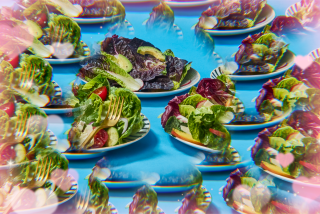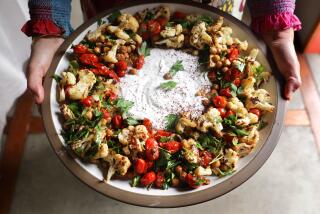Lighten Up
- Share via
With all of the emphasis on the need to follow a healthful diet these days, it’s not surprising that the market for low-calorie/low-fat salad dressings is alive and well. Salads have always been popular in California--the bigger and fresher, the better.
But in spite of their popularity, until about five years ago, most diners thought nothing of slathering favorite salads with a thick, creamy--and highly caloric--blue-cheese dressing.
For the record:
12:00 a.m. Sept. 1, 1988 For the Record
Los Angeles Times Thursday September 1, 1988 Home Edition Food Part 8 Page 11 Column 1 Food Desk 1 inches; 26 words Type of Material: Correction
In last week’s article on salad dressings, the statement was made that coconut and palm oils are high in cholesterol. These oils are high in saturated fats but contain no cholesterol.
Have things changed? Absolutely. Thin is in. And so is good nutrition.
No longer do most of us, with a clear conscience, top a crisp fresh salad with 400 calories worth of salad dressing. Just walk into the nearest supermarket and survey the increasing number of reduced-calorie commercial dressings on display and you’ll quickly realize it’s definitely a dieter’s world today. The array is mind-boggling.
There are thick dressings, thin dressings, spicy sweet-and-sour dressings, low-calorie blue-cheese dressings--all geared to add flavor to salads and other foods without adding unwanted calories and fats.
The only problem with many commercial dressings is that although they have taken out the calories, the manufacturers have, of necessity, left in stabilizers, preservatives and other additives that those watching their nutritional intake may prefer to avoid. Even good label readers often can be misled. All-encompassing terms such as vegetable oils, for instance, can conceal the fact that the oils used may be high-cholesterol vegetable oils such as coconut or palm oils.
Granted these dressings are convenient, and many are, indeed, nutritionally worth their cost. However, the one sure way to know exactly what’s in the salad dressing is to make it yourself. And that is much easier and much less time-consuming than one might think.
It all depends on the type of salad dressing you prefer.
If you like a light vinaigrette-type dressing, it’s a simple matter to reduce the calorie content by replacing part of the oil with tomato pulp or some other pureed fruit or vegetable to cut the sharpness of the vinegar used.
Unflavored gelatin is another ingredient that will provide body in an oil-free dressing, while low-fat cottage cheese and buttermilk, when combined, make an acceptable substitute for sour cream in a cream-style dressing.
A somewhat more unusual choice as a stabilizer-thickener for a salad dressing is plain old rice. That’s right . . . rice.
I first heard of using rice for this purpose in a dressing many years ago. Where I don’t remember. But until recently I hadn’t tried it. And, believe it or not, it really does work. And it works well.
To create a rice-based dressing, cook a small amount of white rice in a large amount of water until the grains burst and become supersoft. This will take about 45 minutes, but once the rice is soft enough to puree, you can make a whole variety of dressings in a blender.
If you only want to make a small amount of dressing, the excess rice base will keep nicely in the refrigerator for five to seven days. If it solidifies as it chills, just throw it back into the blender or bring to room temperature and whisk vigorously to reliquefy it.
Because it is a very bland food, the cooked-rice base acts as a stabilizer and natural filler rather than as a flavoring agent. Thus it can be mixed with almost any other ingredients to create the type of dressing you want.
Although the following recipes include one for the rice base and two suggestions for how to use it, a small amount of experimentation will show how easy it is to substitute this almost flavorless base for all or most of the oil in other dressings. And there is still another plus for this oil-less base. It holds other ingredients such as bits of onion and peppers in suspension nicely, so there’s no need to shake or stir it often when you use it.
You should also be alert to one drawback. I used a red wine vinegar with the rice base and wound up with a most unappealing dirty-gray solution. The mixture tasted fine, but I had to close my eyes to add it to my salad. A better solution is to use lemon juice or a white wine vinegar for the acidic ingredient.
And if you choose to add minced herbs, rather than throwing them into the blender with the rice and the other ingredients, stir them into the dressing after everything else has been pureed. This, too, will avoid a certain amount of discoloration in the finished product.
Here are recipes for the rice-based dressings and several others that will let you savor salads to your heart’s content sans a guilty conscience.
RICE DRESSING BASE
4 cups water
1/2 cup rice
Bring water and rice to boil over medium heat, stirring occasionally. Reduce heat and simmer mixture 45 minutes or until rice grains split and are very soft. Remove from heat and place mixture in blender container. Makes 2 1/2 cups, about 9 calories per tablespoon.
HONEY-LIME RICE DRESSING
1 1/3 cups Rice Dressing Base
3 to 4 tablespoons honey
1 tablespoon Dijon mustard
1/4 teaspoon grated ginger root 2 teaspoons lime juice
1/4 teaspoon lime zest
Place rice base, honey, mustard, ginger and lime juice in blender container and blend until creamy. Stir in lime zest. Refrigerate until 1 hour before serving. Serve at room temperature. Makes 1 1/2 cups, about 17 calories per tablespoon.
HERBED TOMATO-RICE DRESSING
1/2 cup Rice Dressing Base
1/4 cup water
1 medium tomato, peeled, seeded and quartered
1 clove garlic, peeled
1 tablespoon balsamic vinegar
2 tablespoons lemon juice
2 tablespoons minced fresh basil or tarragon leaves
Salt
Combine rice dressing base, water, tomato, garlic, balsamic vinegar and lemon juice in blender container and blend until creamy. Stir in basil and season to taste with salt. Makes 1 1/2 cups, about 5 calories per tablespoon.
LOW-CALORIE LEMON FRENCH DRESSING
1/2 teaspoon unflavored gelatin
1/4 cup cold water
1/2 cup boiling water
1/4 cup lemon juice
Sugar substitute to equal 1 tablespoon sugar
1 teaspoon minced onion
1/4 teaspoon curry powder
1/4 teaspoon paprika
Few strips lemon zest, optional
In jar with tight-fitting lid soften gelatin in cold water. Add boiling water. Cover and shake to dissolve gelatin. Add lemon juice, sugar substitute, onion, curry powder and paprika. Shake well.
Chill about 1 1/4 hours or until dressing begins to thicken. Shake well. Add lemon zest for garnish, if serving separately. Serve with crisp green salad. Makes 1 cup, about 5 calories per tablespoon.
LOW-CALORIE BLUE CHEESE DRESSING
1 cup low-fat cottage cheese
1 tablespoon lemon juice
1/4 teaspoon salt
1/3 cup water
2 ounces blue cheese
White pepper
Garlic powder
Onion powder
Combine cottage cheese, lemon juice, salt and water in blender or food processor container and blend until smooth and creamy. Add blue cheese and blend until nearly smooth. Season to taste with white pepper, garlic powder and onion powder. Store covered, in refrigerator. Will keep up to 5 days. Makes 1 1/2 cups, about 15 calories per tablespoon.
LOW-CALORIE TOMATO DRESSING
1/2 teaspoon dry mustard
1 (6-ounce) can tomato juice
1 clove garlic, minced
3 tablespoons oil
2 tablespoons lemon juice
Dash pepper
Chopped green onion
1 tablespoon Worcestershire sauce
Salt
Blend mustard with a little tomato juice and let stand 5 minutes. Add garlic, remaining tomato juice, oil, lemon juice, pepper, 1 tablespoon chopped green onion and Worcestershire and beat well. Season to taste with salt. Store in covered jar and chill.
Shake well before using. If serving separately, sprinkle with additional chopped green onion before serving. Serve with greens or avocado halves. Makes 1 cup, about 26 calories per tablespoon.
CENTURY PLAZA LOW-CALORIE BUTTERMILK DRESSING
1 1/2 cups low-fat cottage cheese
3/4 cup low-fat buttermilk, about
1 tablespoon lemon juice
1/4 teaspoon white pepper
1/2 teaspoon salt
1 tablespoon minced green onion
1 tablespoon chopped parsley
Place cottage cheese, buttermilk, lemon juice, white pepper and salt in blender container. Blend until smooth. If too thick, add more buttermilk. Stir in green onions and parsley. Makes 2 1/3 cups, about 10 calories per tablespoon.
Food Styling by Minnie Bernardino and Donna Deane
More to Read
Eat your way across L.A.
Get our weekly Tasting Notes newsletter for reviews, news and more.
You may occasionally receive promotional content from the Los Angeles Times.










